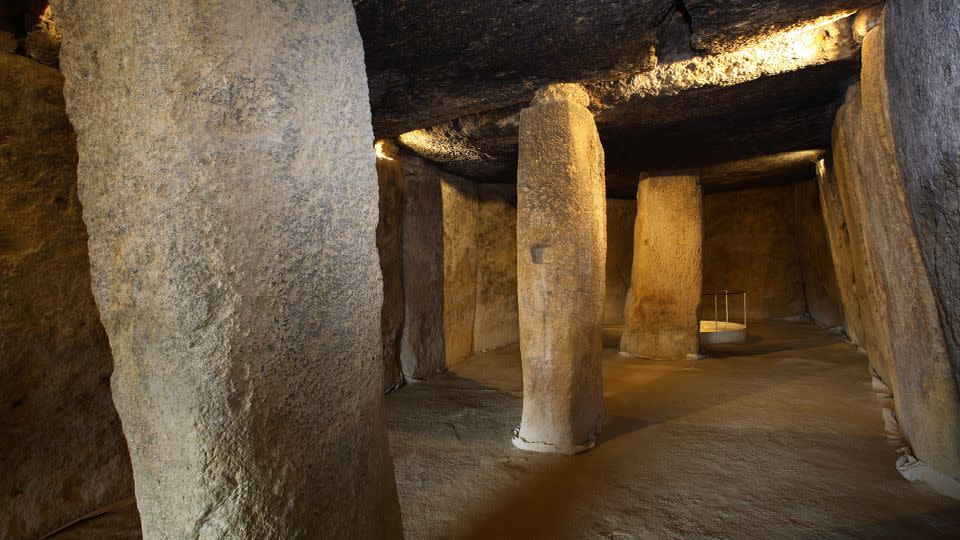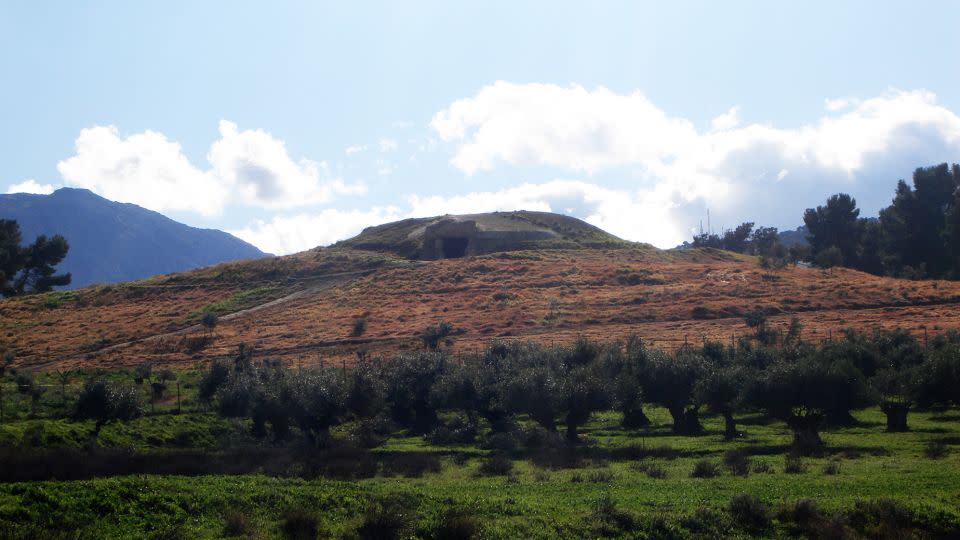Sign up for CNN’s Wonder Theory science newsletter. Explore the universe with news about fascinating discoveries, scientific developments and more.
Each of the 32 colossal stones that make up the Menga Dolmen, a 5,600-year-old megalithic monument in southern Spain, is many times larger than the largest megaliths of Stonehenge, the most famous Neolithic wonder.
Embedded in the ground on a hilltop that rises about 50 meters (165 feet) above the surrounding plain, the stones form a dolmen, or single-chambered tomb, about 25 meters (82 feet) long and 5 meters (16.4 feet) wide at its widest point. The largest single stone weighs about 150 metric tons, about the same as a blue whale and almost five times heavier than the largest component of Stonehenge. Together, the megaliths weigh about 1,140 metric tons.
“I tell students in my lectures … the weight is more than two Boeing 747 planes put together, the planes that fly across continents and so on, fully loaded with fuel and passengers,” said Leonardo García Sanjuán, one of the co-authors of a new study on the monument and a professor of prehistory at Spain’s University of Seville.
“It’s a huge, huge amount of stone, and it’s always been a mystery and an intriguing scientific question how on earth it could have been built, given the technology that they had in the Neolithic.”
The results of a decade-long research project, published Friday in the journal Science Advances, attempt to answer this question, revealing the surprisingly advanced engineering skills required to achieve such a feat.
“I had noticed that the stones had been carefully placed without gaps, but this paper shows how precisely that must have been done, with an extraordinary eye for size and angle,” said Mike Parker-Pearson, professor of British later prehistory at University College London, who described it as “one of the world’s great megalithic wonders.” Parker-Pearson was not involved in the research.
How to build a megalith
The project, led by José Antonio Lozano Rodríguez, a geologist at the Oceanographic Centre of the Canary Islands, mapped how the stones were cut, transported and placed, using the topography and geology of the site, information from previous archaeological excavations and ethnographic and historical accounts of construction techniques.
The upright stones that made up the walls of the chamber were not perfectly vertical. They were tilted slightly inward, making the building narrower at the roof than at the floor. This created a trapezoidal chamber.
The team calculated that each upright stone leans inward at a largely uniform angle of 84 to 85 degrees. The upright stones that form the walls also lean sideways against each other at a consistent angle. The architect and builders would have used tools such as levels and squares to achieve such consistency and accuracy, the study found.

“The precision of the corners is millimeter work,” García Sanjuán said. “They turned it into a Tetris, like the video game.”
He added: “The stones were placed and cut so that they would be slightly inclined and perfectly aligned. Each block must fit exactly with the other and each block supports the other. All the stones are interlocked and embedded in the bedrock.”
One unique feature of the monument that emerged from the research is how the upright stones were initially placed, probably with the aid of a counterweight, in foundation trenches so deep that up to a third of the stones were below ground when they were first erected.
After the walls were completed, the builders placed five huge capstones to form the roof. The builders then removed the earth to the desired floor level and placed stone pillars for additional support.
“When the keystones were added, it looked like a solid box, with the bedrock still inside. Then they cut away all those rocks, all that bedrock, to make the room,” García Sanjuán said.
The resulting building was then covered with a mound of earth, which would insulate the room from cold and wet weather, as well as serve as a “straitjacket” to increase the stability of the structure, he added.
García Sanjuán said it is not entirely clear how the dolmen was used, probably as a temple and tomb, although few archaeological remains have been found inside the relic. The article suggested that one of the reasons it was built to withstand the centuries was because the region is seismically active.
Parker-Pearson said the creators wanted to create a solid structure that would last forever.
“While the authors of the Menga paper suggest that this might be something to resist earthquake damage, I think there is a more important reason why stone monuments like Menga, Stonehenge and many others are built so solidly, namely the attempt to withstand it,” he said.
“This connection of stone with the eternal is something that I believe is a feature common to all prehistoric megalithic dolmens (and other tombs) of Western Europe,” he added.
“In most cases these are tombs and dolmens for the dead, which forever house ancestors who were also considered eternal.”
How were the stones transported?
Research published in December 2023 by the same team identified the source of the stones used to build the monument: a quarry 850 meters (0.5 miles) away, some 50 meters (164 feet) higher than Menga’s site — favorable topography that would have allowed the transport of the enormous stones along a gentle slope.
This research showed that the builders probably designed a path or road to minimize the friction of the relatively soft rock against the ground. They did this by driving closely spaced wooden poles or planks into the ground and transporting the stones using enormous wooden sledges steered by large ropes.


The dolmen was also built along a similar sloping path from the back of the chamber to the entrance, allowing the stones to move along the same axis during the construction process.
“These new insights into the engineering skills, together with the size of the dolmen’s enormous stones, confirm that these people from the early Copper Age of Iberia intended to build a super-sturdy monument,” Parker-Pearson said via email.
“With such large stones, they could not afford to make any mistakes in maneuvering them into place. If even one was a few inches off, it would have been difficult to correct once an upright stone was placed in the trench.”
The new study described the Menga Dolmen as a unique example of “creative genius” and “early science” in a Neolithic society, a time when agriculture had only recently been adopted as a way of life and tools were made largely of stone and other natural materials rather than metal, and no written language existed.
“You see that these people knew about physics, friction, angles. They knew about geology. They knew the properties of the rocks, they knew about geometry,” García Sanjuán said.
“Put these things together (and) what do you have? We have to call it science. We’ve never talked about Neolithic science, just because we’re too arrogant to think that these people could do science like we do.”
“If an engineer today were to try to build Menga with the raw materials that existed 6,000 years ago, I don’t think he could do it.”
For more CNN news and newsletters, create an account at CNN.com